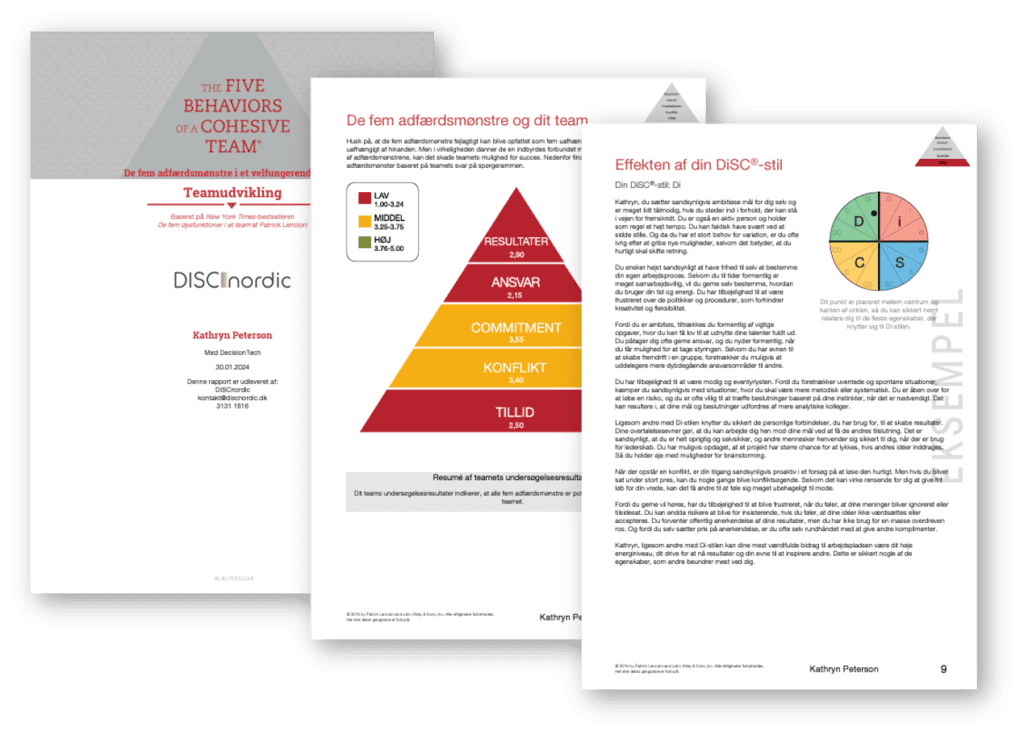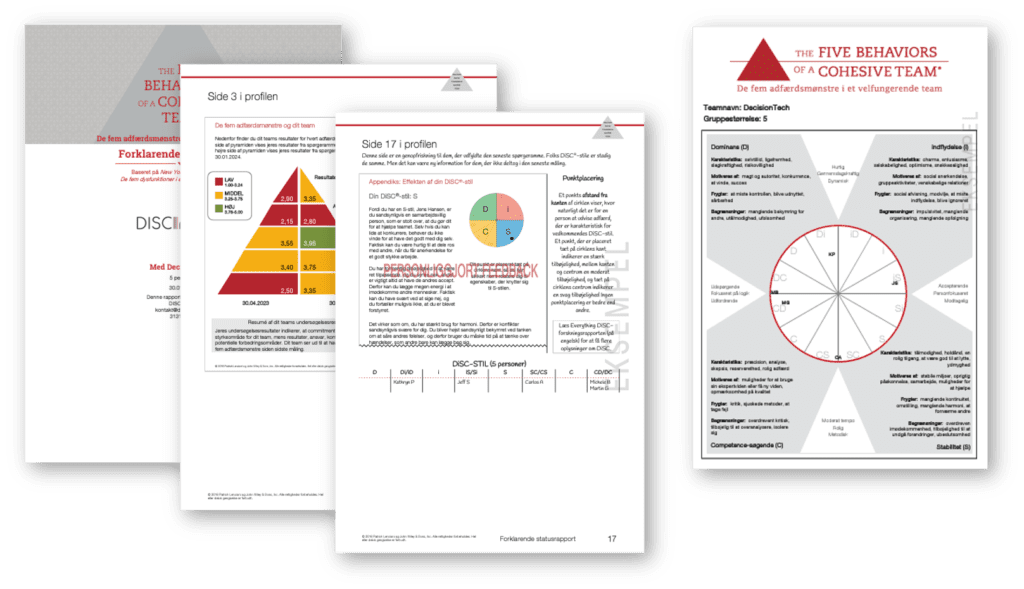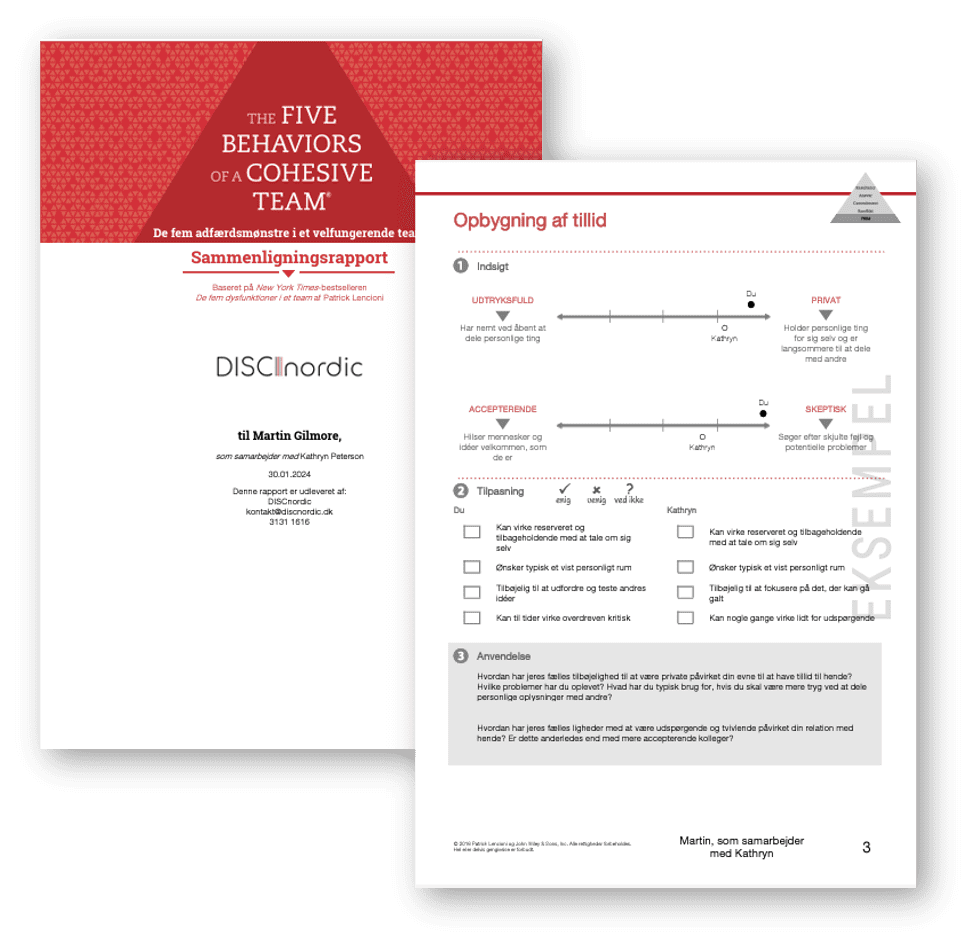The Five Behaviors®
The Five Behaviors® is a unique team tool created to support managers and teams in the process of becoming well-functioning and “high performing”.
The Five Behaviors® is a nuanced and effective team tool for the experienced facilitator. The tool is based on the American bestseller “The Five Dysfunctions of a Team” by Patrick Lencioni.
The tool is the result of a fusion between Everything DiSC® and Patrick Lencioni’s bestseller “The Five Dysfunctions of a Team”.
Separately, the two models are renowned for their efficiency and intuitive accessibility at all levels of an organization. Together, they are nothing short of unique in their transformative power.
DISCnordic is an Authorized Partner and provider of Wiley’s The Five Behaviors® tool.
The Five Behaviors®
The Five Behaviors® model is designed as a layered triangle and consists of these levels:
Trust
All team members must feel safe enough to be vulnerable with each other, which is the foundation for trustbased teamwork.
Conflict
The unfiltered, constructive debate and exchange of ideas can only be made possible through vulnerability and trust, which is established in the first level.
Commitment
Once the team members have shared their opinions and ideas through a constructive discussion, the best ones are then chosen – through this process team-commitment emerges.
Accountability
Team members hold each other accountable because of clear action plans and clear distribution of roles.
Results
The ultimate goal for a team is to achieve results. This is possible only when the four prior levels are implemented. The team members must prioritize collective goals above their own.
Target group
The Five Behaviors® is a nuanced and effective team tool, which is primarily intended for experienced facilitators and consultants who work high level (leaders) with team dynamics and development.
It is an advantage to have knowledge of Everything DiSC®, but it is not a requirement.
Applying The Five Behaviors®
To use The Five Behaviors ® you need access to EPIC, which is the platform from where you send links to respondents and generate reports for download. We recommend that you have completed The Five Behaviors® – Get Started – Crash Course and familiarize yourself with the supporting materials to which we offer sparring and support.
There are different profiles and you can choose between different languages. Contact us to hear more.
When all participants in the team have completed their profiles, following reports are available for download:
The next step is to follow the development in the team, which you can do with the Progress report.
It is a free report that gives the facilitator the data to assess the team’s progress relative to the five levels the team works with.
This way the basis for data-driven team development emerges.
You can create as many Progress reports you want – at no extra cost, e.g. with 3-4 month intervals to keep constant track on the team’s development.
When all the participants have completed the follow-up questionnaire, following reports are available for download:
Once the participants have completed their profiles, you can generate Comparison reports.
The Comparison report is a tool to support facilitating one-to-one conversations between two respondents participating in the same team process.
The concept is similar to the Comparison reports in Everything DiSC® but with the big difference, that the participants are compared on 10 continua – two for each of the model’s five behaviors. That means two for Trust, two for Conflict, etc. This way, the participants are given a unique opportunity to discuss their different approaches to the five behaviors, and thereby achieve a greater understanding of each other.
The Five Behaviors® – Get Started – Crash Course
Step 1
The Five Behaviors® - Get Started - Crash Course
Introduction
This module is an introduction to the structure of the course, the story behind it, the model and theory, and the tool in its entirety.
You are also presented with how to structure a team process as well as some general thoughts about facilitating a team process.
See sample reports here:


Step 2
The Five Behaviors® - Get Started - Crash Course
Trust
This module explains the first behavior of the model: Trust.
First, we explain the definition of Trust in this context, then go through the report content about Trust and discuss how to work with it in a facilitation situation.
In this module the participants are introduced to the DiSC model.
Ideas and suggestions for facilitation are provided and we raise some points of attention.
Step 3
The Five Behaviors® - Get Started - Crash Course
Conflict
This module explains the the second level of the model: Conflict.
First, we explain the definition of Conflict in this context, then go through the report content about Conflict and discuss how to work with it in a facilitation situation.
Ideas and suggestions for facilitation are provided and we raise some points of attention.
Step 4
The Five Behaviors® - Get Started - Crash Course
Commitment
In this module we discuss the model’s third level, Commitment, and explain Clarity & Buy-In.
We go through the report content about Commitment and discuss how to work with it in a facilitation situation.
Ideas and suggestions for facilitation are provided and we raise some points of attention.
Step 5
The Five Behaviors® - Get Started - Crash Course
Accountability
In this module we discuss the fourth level of the model: Accountability.
First, we explain the definition of Accountability in this context and the normal misunderstandings linked to this concept.
Then we discuss the report content about Accountability.
Ideas and suggestions for facilitation are provided.
Step 6
The Five Behaviors® - Get Started - Crash Course
Results
In this module we discuss the model’s fifth and final level: Results.
First, we explain the definition of Results and discuss ‘primary team’ thinking.
The report content about Results are reviewed, and ideas and suggestions for facilitation are provided.
Step 7
The Five Behaviors® - Get Started - Crash Course
The Progress Report
The Progress report is the strongest card in this tool.
It is a free report that gives the facilitator the data to assess the team’s progress relative to the five levels the team works with.
This way the basis for data-driven team development emerges.
You can create as many Progress reports you want – at no extra cost, e.g. with 3-4 month intervals to keep constant track on the team’s development.
See sample reports here:
Step 8
The Five Behaviors® - Get Started - Crash Course
The Comparison Report
The Comparison report is a tool to support facilitating one-to-one conversations between two respondents participating in the same team process.
The concept is similar to the Comparison reports in Everything DiSC® but with the big difference, that the participants are compared on 10 continua – two for each of the model’s five behaviors. That means two for Trust, two for Conflict, etc. This way, the participants are given a unique opportunity to discuss their different approaches to the five behaviors, and thereby achieve a greater understanding of each other.
See sample reports here:
Step 9
You have now completed The Five Behaviors® – Get Started – Crash Course.
Contact us via the form and we will help you further.
Everything DiSC® and The Five Behaviors® is a registered trademark of John Wiley & Sons Inc., or its affiliated companies.





